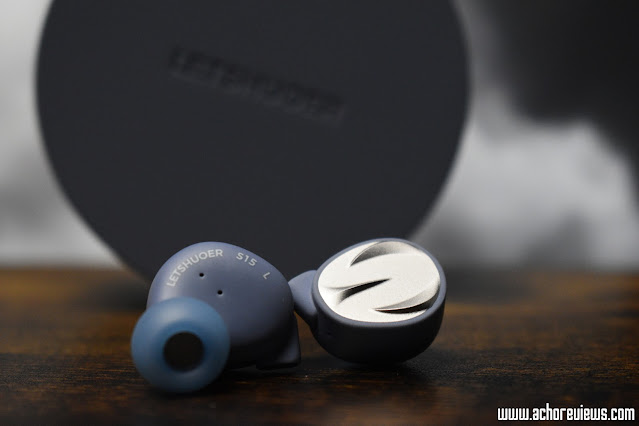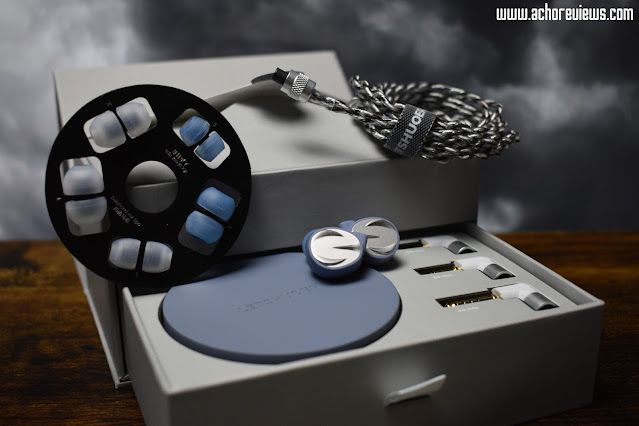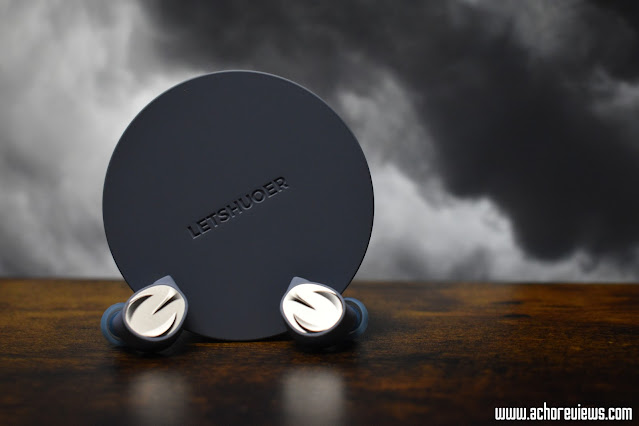- Get link
- X
- Other Apps
English | Español
TLDR version on YouTube: TDLR - Letshuoer S15
The Letshuoer S15 have been sent to me directly by Letshuoer in exchange for the publication of my opinions in this review. They have made no requests or comments and I will do my usual best to be as unbiased as possible.
The official page for the S15 can be found here: https://letshuoer.net/products/letshuoer-s15-third-generation-14-8mm-planar-driver-r-sonic-passive-filtering-module-hifi-wired-in-ear-monitor
As always, this is a non affiliate link.
To avoid being repetetive in my reviews, you can find all the info about how I create the reviews, equipment used, how I receive the products and how to interpret my reviews by visiting: About my reviews
Intro…
The S15 is the latest release from the company who made one of my favourite planar IEMs, the S12. The S12 were the set I would reach for when I just wanted to listen to music and reset from reviewing things, they got a lot of ear time and they are still in the 10 sets that I most use when I am not reviewing something specific.
Therefore, when I was offered the chance to try out the new planar option, the S15, which features the same size 14.8mm planar driver but now in its third generation, along with a new passive radiator filter, I was excited to give them a listen.
Letshuoer already released a set with a passive radiator not too long ago, the DZ4, and I mentioned the fact that the way they had implemented it was not really what I would call a passive radiator. This did give them a bit of a unique sound that reminded me of a slight tube flavour. Whether it was due to the strange implementation of the PR or not, it was still something that I found very enjoyable for a lot of acoustic music.
When the rumours of the S15 started to appear, there was mention of a passive radiator being used in this set together with the planar driver, something that seemed even stranger than the set up in the DZ4.
However, when the info finally emerged, the S15 are not spec’d as having a passive radiator, rather a “6mm R-Sonic Passive Filtering model”. In this case there seems to have been a lot more thought put into the set up, using acoustic tubes with a filter crossover, meaning that it is not just a driver without a coil put into a shell.
There is a whole page on the Letshuoer site about the “R-Sonic” system, explaining how it works and that it is not PR but a PFM. I am not going to go through it all here as you can just visit the page (here) if you would like to read it in detail, but in short they say that is is an adjustable module for tuning ear pressure, kicking in when the SPL is higher.
I don’t know exactly at what SPL this is supposed to activate but I am someone who listens at low volumes, so I thought maybe I would be missing out on the fun. However, I have spent some time comparing it at low volumes and higher volumes and personally cannot tell a difference in sound, other than it being louder which can subconsciously lead to thinking that the sound is automatically better.
So, let’s talk about the S15 as a whole and how it performs to my ears.
Presentation…
The S15 is not a cheap set of IEMs, selling at $329 on the Letshuoer site. Of course there are obviously many models out there that are much more expensive but it is still on the higher end of the range of many planars we have available. I have to say that I personally feel that the presentation is on a level that is expected at this price.
A simple grey sleeve that shows the make and model on the front, with minimal specs on the back, slides away to reveal a simple flip top box of the same colour, with just Letshuoer “Sound Alive” on the top in very small text.
Flipping open the box, which is held closed by magnets, reveals something that resembles a small valet box with a drawer (for lack of a better comparison). The top layer is a grey card envelope that contains the warranty card and a poster that has art on one side and the user manual printed on the back. I am not one for posters but I like the originality of presenting the user manual this way.
After removing the envelope we find the IEMs sitting in next layer in usual hard foam cutouts but in this case, they have been covered with matching grey card which makes it look a little more premium.
Below this there is a drawer that pulls out from the front and contains the accessories. The accessories are a round screw top ,atte blue storage case (which matches the finish of the IEMs), a very nice cable with interchangeable connectors, the connectors for said cable (3.5mm, 4.4mm and 2.5mm) and a disc with the additional tips. In total we get 6 sets, 3 sizes of “vocal” ear tips (which are blue) and 3 sizes of “balanced” ear tips.
In general the presentation is elegant, with the needed accessories included, and does give a more premium feel than other packaging.
Build and aesthetics…
The IEMs are very compact and opt for a matte blue plastic shell along with a CNC carved aluminium faceplate, meaning they are also very light. The nozzles are rather short yet the tips have quite a shallow fit onto them, which makes them seat nicely inside my ears, getting an easy seal and no discomfort or fatigue over longer periods. Of course, my ears are unique and so are everybody else’s, so comfort will be a very personal thing but I have to say that they are something that I find very comfortable.
As said in presentation, the cable is nice, using a black and silver wrap inside a clear finish for each side, which in turn, is wrapped below the divider. The cable feels nice and is not overly thick, nor overly thin, it is just around where i like it.
The cable uses metal hardware at both ends, with a metal divider but clear plastic chin slider. However, the only thing I found strange with the cable is that the 3 included interchangeable connectors are finished in a white matte plastic. I have absolutely no issue with them being plastic, they are nice to the touch and feature the Letshuoer logo, yet, if we are going plastic, why not make the a blue that matches the IEMs (and storage case) or just go with metal and have them match the rest of the cables hardware. It is not really a complaint, I still think it is a very nice cable, it just seems to be a 0.1% thing that could have added even better aesthetics.
Sound…
All tracks mentioned are clickable links that allow you to open the reference track in the streaming service of your choice (YouTube, Tidal, Qobuz, Spotify, etc.)
I have to say that the S15 are quite a step away from the S12, which can be a good or a bad thing, depending on what you want from the IEMs.
There are two things that I find stand out straight away when comparing the two models, which I guess shouldn’t really be compared as they are not really in the same range, but seeing how much I love the S12, how could I not?
The first is the fact that the higher ranges of the S15 reduce their presence quite a bit in comparison. After playing with the two types of included tips, I found myself enjoying the “vocal” tips much more but I didn’t find that either of them really brought the upper ranges up, just that the “vocal” option seemed lusher in its presentation with my favourite female vocals.
The second is detail, especially in the low end. I don’t think that it is the fact that they are much more detailed per se, I just find that the details have more authority and separation, without becoming in your face. There is certainly no “fake detail” from upper range boosts with the S15.
But anyway, let’s get on with my usual test list and opinions, starting off with our look at the graph in comparison to my usual preference curve:
Starting off, as always, with the subbass and my obligatory listen of “Chameleon”, there is certainly a presence of subbass but it is not overly boosted. While the subbass is there and is capable of rumbling, I would say that there is actually more focus on the midbass. Again, that doesn’t mean that subbass is lacking, at least for me, there is not a huge amount of rumble in things like “Royals”, although that “dirt” that I associate with the subbass of this track is easily appreciated.
As I just said, I find that there is more of a focus on a punchy midbass than there is on a rumbling low end and I have to say that I am impressed. “No Sanctuary Here” is very punchy and present in its midbass yat it is clean and remains totally controlled at all times. It is also very detailed and, as I said a moment ago, more “authoritative” in those details than on other planar sets that I have heard. I have no idea if it is due to the PFM or not but I think this is the most “dynamic driver” like midbass I have heard from a planar IEM.
Moving into the mid range, I find that the there is a continuation of the midbass clarity. In fact, the mid range is very similar to that of the S12 yet, again, I find it to be slightly more textured and have more weight to it. The timbre of instruments is very natural in the lower and mid ranges, with acoustic guitars having plenty of body but without being overly boosted in those lower ranges, or at least not giving the impression of being overly boosted.
As we start climbing into the upper mids and then the lower treble, this is where the S15 differ quite a bit from the S12 or many of the other planar IEMs that are on the market at the moment. Between 1.5kHz and 2kHz, there is a presence that compensates the lower end but then it drops away, being more on the darker side in these upper ranges.
If you are someone who like a lot of clarity and air in the upper ranges, with an emphasis on vocals, then the tuning of the S15 is not something that will really match your preferences. However… although there isn’t much presence in the upper mids and treble ranges, the clarity of the lower regions works very well to avoid the general sound signature becoming muddy or hazy in general.
Vocals are smoothed over yet they are not dark and distant, they come across as having a lushness to them, as I mentioned in the lower ranges, that is actually very pleasant to listen to. While I would never choose this tuning of the higher ranges for me personally, I was very surprised to find how much I actually enjoy listening to the S15.
Sibilance is avoided, as is any harshness in the upper ranges, yet, again, it does not push things so far back that they become too dark. It is an approach that I think moves us away from focusing on minute details and more into the relaxed listening mood. Saying that, it is surprising how many details can be appreciated in the lower ranges, without any peaks that greet us with a fake sensation of detail. In other words, there is no emphasis nor impression of “look what I can do”, it is more of a case where they simply do their intended job and they do it very well.
Conclusion…
I am surprised to find that the S15 are as enjoyable as they actually are. I had seen graphs of the response before listening to them and I was really expecting a midbass focused dark mess.
While they are focused on warmth, they don’t overdo it in the bass ranges at all. On top of this, they are very detailed and perform very well in the lower ranges, making for a very natural timbre of instruments in these frequencies. Yes, there is a lack of upper shine and air, so if you are looking for a brighter set of IEMs then these probably won’t fit the bill, yet they manage to still be a very enjoyable set of IEMs that I find to be a very pleasurable listen.
Again, at the risk of repeating myself, I feel that the the S15 have the most dynamic driver sound to the lower ranges and mids that I have heard in a set of planar IEMs and I like it!
All FR measurements of IEMs can be viewed and compared on achoreviews.squig.link
All isolation measurements of IEMs can be found on achoreviews.squig.link/isolation
To comment or contact, visit any of the following social media platforms:







